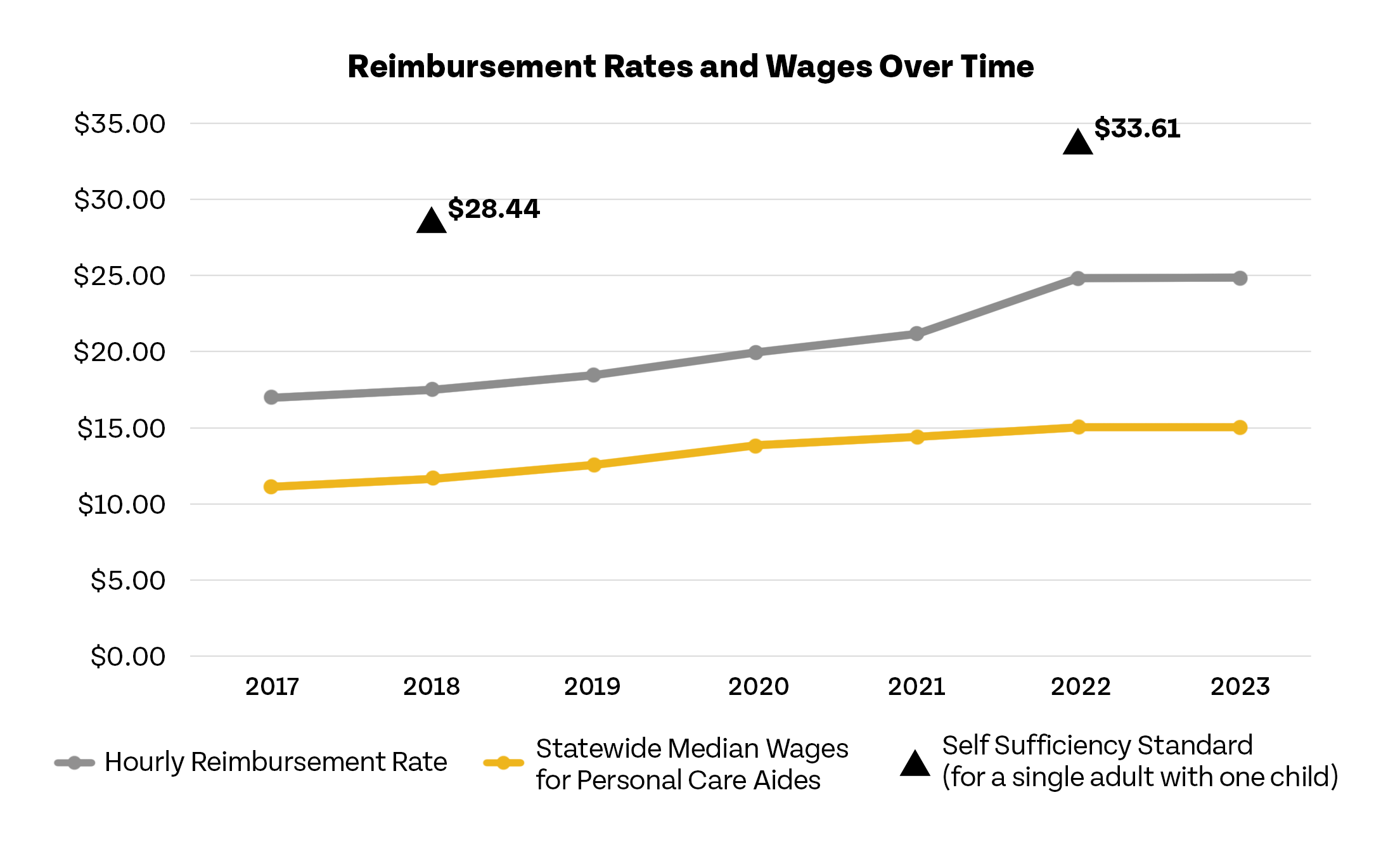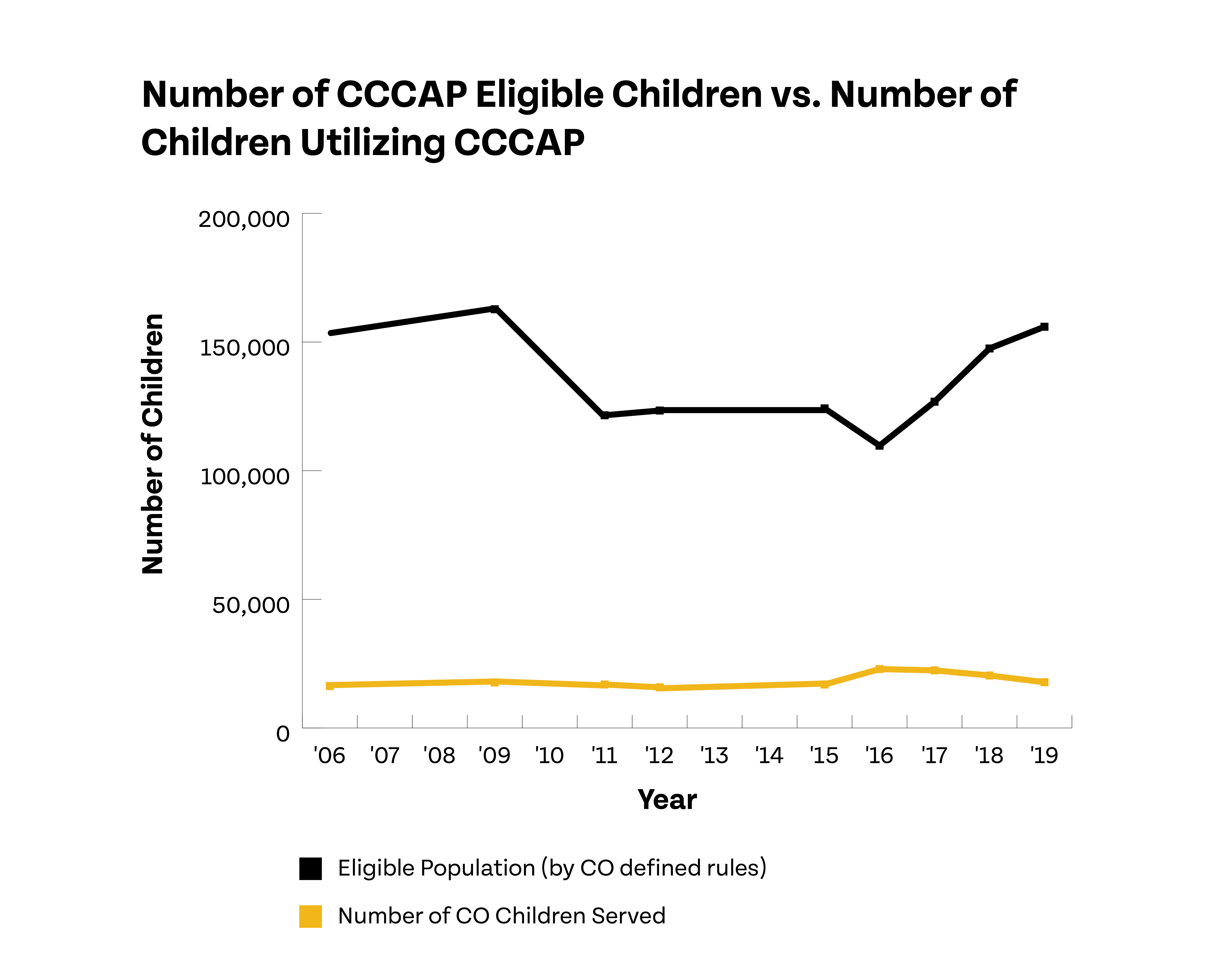What to look for in the 2024-2025 Budget to Support Care
What to look for in the 2024-2025 Colorado State Budget to Support Care
The Bell has long worked to ensure public funding for important services our communities need. The Colorado state budget process is one of the ways funding decisions are made, with powerful impacts on public programs. Care is one of those critical services that help communities thrive as care workers provide essential care to children, older adults, and people with disabilities and support people’s ability to work. However, up to this point, care workers are undervalued and underpaid, leaving the caring workforce with high turnover and a limited ability to provide enough consistent, quality, and affordable care to those who need it. As the Joint Budget Committee (JBC) begins the annual process outlining the state’s budget, we want to highlight specific line items that will strengthen the care economy.

Budget Line Items and Their Impacts
The main departments overseeing issues related to care are the Department of Health Care Policy and Financing (HCPF), the Colorado Department of Early Childhood (CDEC), and the Department of Human Services (DHS). DHS and HCPF’s budget primarily impact care for older adults and people with disabilities, while CDEC will impact early childhood education (ECE) and child care.
Health Care Policy and Financing (HCPF)
Provider Rates: Community and Targeted Provider Rates
HCPF’s budget has one of the largest budgets in the state. Within this budget, it is important to pay attention to the “Provider Rates.” Provider rates are the reimbursement or payment to service providers from the state in exchange for the services provided. HCPF’s direct care services (which involve support for older adults and individuals with disabilities) are provided through the state’s Medicaid program. As such, direct care provider rates are synonymous with Medicaid reimbursement rates. The provider rates are meant to cover the total cost of care provided, overhead, administrative costs, and wages and benefits for service providers. This budget line item is divided into community provider rates and targeted provider rates. Community provider rates incorporate a large group of providers, of which direct care workers are a part. Targeted provider rates are used to isolate a specific type of provider that may require special attention.
There is an overall shortage of direct care workers in the state although the need for direct care is only growing. Part of the reason for this shortage is the low pay compared to the demanding nature of the job. The provider rates for direct care workers are important as they are the main funding source for the long-term care provided for older adults and those with disabilities. Because these rates are subject to a constrained budget and are meant to cover many costs in addition to wages, direct care workers have received too low wages for many years, shown below.

Although the recent minimum wage increased for Direct Care Workers, $15.75 per hour or $17.29 per hour in Denver, low provider rates can make meeting the Colorado and Denver minimum wage increases difficult and burdensome to achieve for employers and remains far below what is considered a self-sufficient wage. Reimbursement rates for direct care workers deserve to be identified in a targeted provider rate to address their low wages.
Related to the low provider rates mentioned above, the care worker shortage has made it difficult for people to access care. However, many people may have the waiver but are not receiving care due to staffing issues. By increasing provider rates, with specific focus on the impact on wages for direct care workers, the state can address care workers’ economic well-being and retention and increase the accessibility of care.
Department of Human Services (DHS)
State Funding for Senior Services (SFSS): Area Agencies on Aging (AAA)
Area Agencies on Aging (AAA) are both federally and state funded to carry out programs and services for older adults as outlined in the Older Americans Act (OAA). The budget line “State Funding for Senior Services” provides funding for the AAAs. AAAs can provide services directly or through contacts with community-based agencies for older adults, their families, and their caregivers to aid them in remaining independent in their community. They provide important services like transportation, nutrition assistance, and case management. There are 16 agencies distributed across the state by region. However, the inadequate funding for AAAs has long been documented by advocates. Moreover, research from the Bell shows funding for older services has remained stagnant even as the number of older Coloradans has grown. As federal aid dollars from the COVID-19 pandemic end, it is important that Colorado consider how to continue supporting AAAs with long-term, comprehensive funding. AAAs are important partners in providing crucial services allowing older adults to continue living independently in their communities as Colorado works to leverage the strengths of our aging population.
Colorado Department of Early Childhood (CDEC)
Provider rates also show up in CDEC’s budget and are similarly distributed to various programs in the early childhood ecosystem. The largest recipients of the community provider rates in early childhood are the Colorado Child Care Assistance Program (CCCAP), along with Early Intervention and the Nurse Home Visitor Program.
The Early Childhood Education (ECE) workforce experiences similar challenges to those mentioned above for direct care workers including low pay, little benefits, and a high turnover rate resulting in important staffing shortages. As it relates to CCCAP, increased provider rates can support better compensation for care workers. Although CCCAP provides a subsidy for the parents and family, it is reimbursed to the care provider directly as compensation for the care provided. These payments, in turn, are at least partially passed on to wages for the care workers. However, with current funding, the provider rates are often cited as too low, and do not actually cover the cost of providing care. Currently, provider rates only pay about 75 percent of the total cost of care. With low provider rates that do not cover the cost of care, in addition to child care businesses running on thin margins, paying care givers adequate wages can be burdensome for the provider and can even limit CCCAP participation among child care providers. With the help of federal funds, the state funded research to shift provider rates based on the cost of care rather than on market rates. The state can change provider rates to implement the findings from this research.
Although provider rates are an important part of CCCAP’s total cost, funding for the program should be considered as it relates to increased accessibility and affordability. In Colorado, child care remains unaffordable for many families. In 2020, CCCAP served over 17,000 children, but remains well below the number of eligible children in need of a child care subsidy, as shown below. In fact, with current funding, only 8.63 percent of the income eligible population was served in 2021-2022.

Additionally, with the help of CCCAP, and federal stimulus funds, parents have a maximum copayment of 10 percent of their income, which is much closer to the 7 percent considered affordable by the U.S. Department of Health and Human Services. Additional funds for CCCAP would help ensure more eligible children can use CCCAP and ensure affordability for families.
During the COVID-19 pandemic, additional federal funds were distributed to states through the American Rescue Plan Act (ARPA) and the Coronavirus Aid Relief and Economic Security (CARES) Act to help states withstand and recover from the pandemic. In Colorado, $271 million in federal stimulus funds were used specifically for child care programs, providers, and to make child care more accessible and affordable. However, as these federal funds expire, the child care funding cliff is estimated to result in a loss of 232,000 child care jobs nationally, with just over 83,000 children in Colorado estimated to lose care as 1,000 providers are expected to close their doors. While some of the federal stimulus strategies to support child care will show up again in this fiscal year’s budget, as some federal stimulus strategies are set to expire in 2025, many have already expired. In either scenario, they are important to keep in mind as these strategies were critically important in sustaining the early childhood ecosystem and remain important beyond the pandemic. Some examples are below, though they are not comprehensive of all the federal stimulus programs.
The Emerging and Expanding Child Care Grant and the Workforce Sustainability Grant are worth highlighting and considering beyond the federal stimulus as they touch on two of the biggest issues facing child care: accessibility of care and the workforce.
The Emerging and Expanding Child Care Grant, which had a funding amount of $10 million, was created with a combination of state and federal dollars in 2020 and was extended with Senate Bill 22-213 using $16 million in funds from the Economic Recovery and Relief Cash Fund. The program provides grants for people who will start or expand their child care business, with a priority for those in areas with a lack of licensed child care and for those who will maintain or expand their capacity for infants and toddlers. Across the state of Colorado, many counties do not have enough licensed capacity to serve all those who may need care, and this is even more dire for infants and toddlers. The cost of starting or expanding a licensed child care business, especially when considering the thin margins providers operate under, are a significant driver of this gap. Grants from the Emerging and Expanding Child Care program directly address this barrier by decreasing the cost to start or expand a child care business as funds can be used for construction purposes, staffing purposes, and more. This grant has so far been successful, with 6,000 extra seats created and more than 1,600 being infant and toddler spots as of March 2023. This grant program has not yet expired and should continue to receive attention from the JBC in the fiscal year’s 2024-2025 budget.
Another reason that expanding or increasing child care seats is difficult, and is a major cost driver of providing care, is the workforce. Like the direct care worker shortage, there are also too few child care workers to meet the need. With low pay, little benefits, and a large responsibility, the turnover in the industry is high. The Workforce Sustainability Grant, with nearly $50 million in funds, has anecdotally been noted by providers as a crucial funding source. These funds were flexible and could be used for a variety of purposes so long as they supported retention and recruitment efforts. For example, the funds could be used for compensation and bonus payments for existing staff, hiring additional staff, or providing various benefits. The deadline for this grant program was September 2022, and funds were spent by September 2023. While other grant programs exist that, among other uses, support the workforce such as the Early Care and Education Recruitment and Retention Grant Program and the Child Care Sustainability Grant Program, they are broader in their uses beyond the workforce and with less funding. As such, the JBC should consider how to continue supporting recruitment and retention efforts moving forward. This grant played an important role in retaining workers in a critical time during the pandemic, however the workforce shortage still presents a challenge to child care providers and communities across the state. Targeted support to care workers is important for the state to fully meet Colorado’s care needs.
Conclusion
The above budget line items should be considered and highlighted as the JBC begins their consideration of the state budget due to their positive impacts on our state’s ability to provide quality care for older adults, people with disabilities, and young children. They will be especially impactful if they continue to receive investment as there are ongoing challenges to providing care to those who need it, while also supporting the care workers who are crucial in achieving our goals of quality, accessible, and affordable care.
